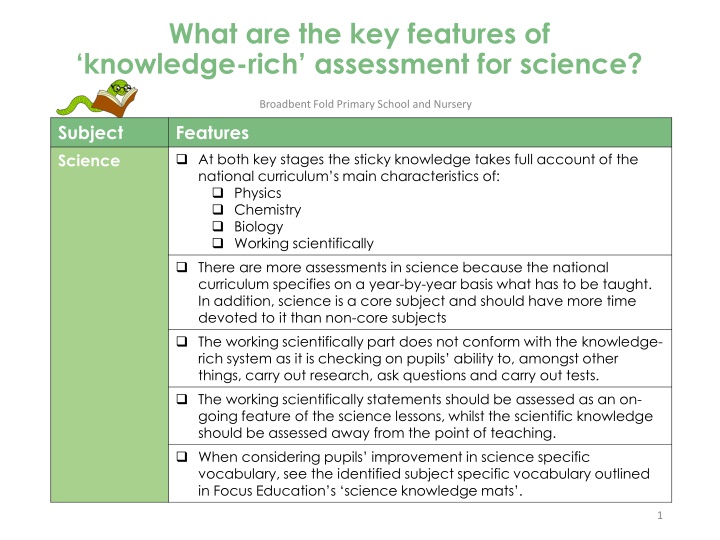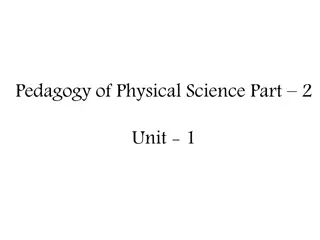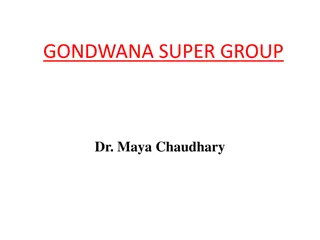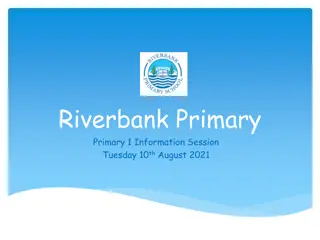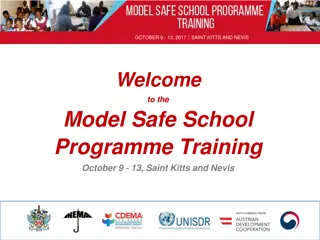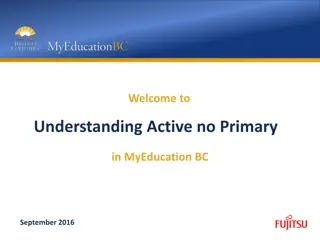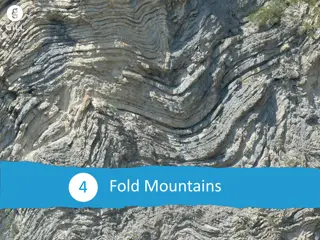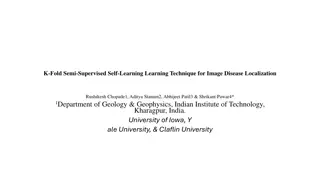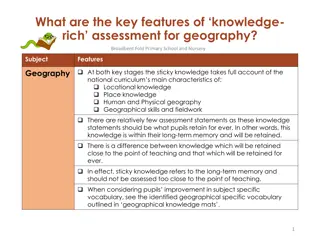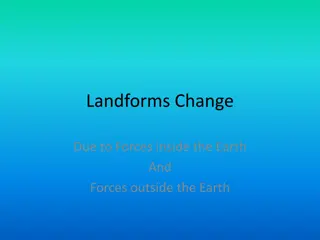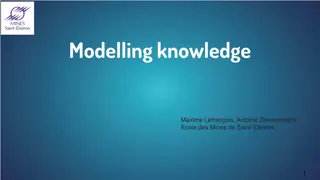Key Features of Knowledge-Rich Assessment for Science at Broadbent Fold Primary School
Sticky knowledge in science assessment at Broadbent Fold Primary School encompasses Physics, Chemistry, Biology, and Working Scientifically. Assessments are detailed due to the structured national curriculum, with a focus on specific scientific vocabulary and practical applications. The ongoing assessment of scientific knowledge and skills is emphasized, with a separate evaluation for the working scientifically aspect. Year 1 curriculum covers topics such as Animals, Plants, Materials, and Scientific Inquiry, fostering a strong foundation in scientific understanding and methodology.
Download Presentation

Please find below an Image/Link to download the presentation.
The content on the website is provided AS IS for your information and personal use only. It may not be sold, licensed, or shared on other websites without obtaining consent from the author.If you encounter any issues during the download, it is possible that the publisher has removed the file from their server.
You are allowed to download the files provided on this website for personal or commercial use, subject to the condition that they are used lawfully. All files are the property of their respective owners.
The content on the website is provided AS IS for your information and personal use only. It may not be sold, licensed, or shared on other websites without obtaining consent from the author.
E N D
Presentation Transcript
What are the key features of knowledge-rich assessment for science? Broadbent Fold Primary School and Nursery Subject Science Features At both key stages the sticky knowledge takes full account of the national curriculum s main characteristics of: Physics Chemistry Biology Working scientifically There are more assessments in science because the national curriculum specifies on a year-by-year basis what has to be taught. In addition, science is a core subject and should have more time devoted to it than non-core subjects The working scientifically part does not conform with the knowledge- rich system as it is checking on pupils ability to, amongst other things, carry out research, ask questions and carry out tests. The working scientifically statements should be assessed as an on- going feature of the science lessons, whilst the scientific knowledge should be assessed away from the point of teaching. When considering pupils improvement in science specific vocabulary, see the identified subject specific vocabulary outlined in Focus Education s science knowledge mats . 1
Year 1 Biology Chemistry Physics Animals, including Humans Animals, including Humans Plants Everyday Materials Seasonal Change Name common animals Carnivores, etc Human body and senses Common plants Plant structure Properties of materials Grouping materials The four seasons Seasonal weather Know how to classify a range of animals by amphibian, reptile, mammal, fish and birds Know and classify animals by what they eat (carnivore, herbivore and omnivore) Know how to sort by living and non living things Know the name of parts of the human body that can be seen Know and name a variety of common wild and garden plants Know and name the petals, stem, leaves and root of a plant Know and name the roots, trunk, branches and leaves of a tree Know the name of the materials an object is made from Know about the properties of everyday materials Name the seasons and know about the type of weather in each season 2
Year 1 Working Scientifically Ask questions such as: Why are flowers different colours? Why do some animals eat meat and others do not? Set up a test to see which materials keeps things warmest, know if the test has been successful and can say what has been learned Explain to someone what has been learned from an investigation they have been involved with and draw conclusions from the answers to the questions asked Measures (within Year 1 mathematical limits) to help find out more about the investigations undertaken 3
Year 2 Biology Chemistry All living things and their habitats Animals, including Humans Plants Everyday Materials Alive or dead Habitats Adaptations Food chains Animal reproduction Healthy living Basic needs Plant and seed growth Plant reproduction Keeping plants healthy Identify different materials Name everyday materials Properties of materials Compare the use of different materials Compare movement on different surfaces Classify things by living, dead or never lived Know how a specific habitat provides for the basic needs of things living there (plants and animals) Match living things to their habitat Name some different sources of food for animals Know about and explain a simple food chain Know the basic stages in a life cycle for animals, (including humans) Know why exercise, a balanced diet and good hygiene are important for humans Know and explain how seeds and bulbs grow into plants Know what plants need in order to grow and stay healthy (water, light & suitable temperature) Know how materials can be changed by squashing, bending, twisting and stretching Know why a material might or might not be used for a specific job 4
Year 2 Working Scientifically Ask questions such as: Why do some trees lose their leaves in Autumn and others do not? How long are roots of tall trees? Why do some animals have underground habitats? Use equipment such as thermometers and rain gauges to help observe changes to local environment as the year progresses Use microscopes to find out more about small creatures and plants Know how to set up a fair test and do so when finding out about how seeds grow best Classify or group things according to a given criteria, e.g. deciduous and coniferous trees Draw conclusions from fair tests and explain what has been found out Use measures (within Year 2 mathematical limits) to help find out more about the investigations they are engaged with 5
Year 3 Biology Chemistry Physics Animals, including humans Plants Plants Rocks Forces Light Skeleton and muscles Nutrition Exercise and health Plant life Basic structure and functions Life cycle Water transportation Fossil formation Compare and group rocks Soil Different Forces Magnets Reflections Shadows Know about the importance of a nutritious, balanced diet Know how nutrients, water and oxygen are transported within animals and humans Know about the skeletal and muscular system of a human Know the function of different parts of flowing plants and trees Know how water is transported within plants Know the plant life cycle, especially the importance of flowers Compare and group rocks based on their appearance and physical properties, giving reasons Know how soil is made and how fossils are formed Know about and explain the difference between sedimentary, metamorphic and igneous rock Know about and describe how objects move on different surfaces Know how a simple pulley works and use to on to lift an object Know how some forces require contact and some do not, giving examples Know about and explain how magnets attract and repel Predict whether magnets will attract or repel and give a reason Know that dark is the absence of light Know that light is needed in order to see and is reflected from a surface Know and demonstrate how a shadow is formed and explain how a shadow changes shape Know about the danger of direct sunlight and describe how to keep protected 6
Year 3 Working Scientifically Ask questions such as: Why does the moon appear as different shapes in the night sky? Why do shadows change during the day? Where does a fossil come from? Use a thermometer to measure temperature and know there are two main scales used to measure temperature Gather and record information using a chart, matrix or tally chart, depending on what is most sensible Observe at what time of day a shadow is likely to be at its longest and shortest Group information according to common factors e.g. plants that grow in woodlands or plants that grow in gardens Observe which type of plants grow in different places e.g. bluebells in woodland, roses in domestic gardens, etc. Use bar charts and other statistical tables (in line with Year 3 mathematics statistics) to record findings Use research to find out how reflection can help us see things that are around the corner Know how to use a key to help understand information presented on a chart Use research to find out what the main differences are between sedimentary and igneous rocks Be confident to stand in front of others and explain what has been found out, for example about how the moon changes shape Test to see which type of soil is most suitable when growing two similar plants Present findings using written explanations and include diagrams when needed Test to see if their right hand is as efficient as their left hand Make sense of findings and draw conclusions which help them to understand more about scientific information Set up a fair test with different variables e.g. the best conditions for a plant to grow Amend predictions according to findings Explain to a partner why a test is a fair one e.g. lifting weights with right and left hand, etc. Be prepared to change ideas as a result of what has been found out during a scientific enquiry Measure carefully (taking account of mathematical knowledge up to Year 3) and add to scientific learning 7
Year 4 Biology Chemistry Physics Animals, including humans All living things and their habitats States of Matter Electricity Sound Digestive system Teeth Food chains Grouping living things Classification keys Adaptation of living things Compare and group materials Solids, liquids and gases Changing state Water cycle Uses of electricity Simple circuits and switches Conductors and insulators How sounds are made Sound vibrations Pitch and Volume Identify and name the parts of the human digestive system Know the functions of the organs in the human digestive system Identify and know the different types of human teeth Know the functions of different human teeth Use and construct food chains to identify producers, predators and prey Use classification keys to group, identify and name living things Know how changes to an environment could endanger living things Group materials based on their state of matter (solid, liquid, gas Know the temperature at which materials change state Know about and explore how some materials can change state Know the part played by evaporation and condensation in the water cycle Identify and name appliances that require electricity to function Construct a series circuit Identify and name the components in a series circuit (including cells, wires, bulbs, switches and buzzers) Predict and test whether a lamp will light within a circuit Know the function of a switch Know the difference between a conductor and an insulator; giving examples of each Know how sound is made, associating some of them with vibrating Know how sound travels from a source to our ears Know the correlation between pitch and the object producing a sound Know the correlation between the volume of a sound and the strength of the vibrations that produced it Know what happens to a sound as it travels away from its source 8
Year 4 Working Scientifically Ask questions such as: Why are steam and ice the same thing? Why is the liver important in the digestive systems? What do we mean by pitch when it comes to sound? Gather and record information using a chart, matrix or tally chart, depending on what is most sensible Group information according to common factors e.g. materials that make good conductors or insulators Use research to find out how much time it takes to digest most of our food Use bar charts and other statistical tables (in line with Year 4 mathematics statistics) to record findings Use research to find out which materials make effective conductors and insulators of electricity Present findings using written explanations and include diagrams, when needed Carry out tests to see, for example, which of two instruments make the highest or lowest sounds and to see if a glass of ice weighs the same as a glass of water Write up findings using a planning, doing and evaluating process Set up a fair test with more than one variable e.g. using different materials to cut out sound Make sense of findings and draw conclusions which helps them understand more about the scientific information that has been learned Explain to others why a test that has been set up is a fair one e.g. discover how fast ice melts in different temperatures When making predictions there are plausible reasons as to why they have done so Measure carefully (taking account of mathematical knowledge up to Year 4) and add to scientific learning Able to amend predictions according to findings Use a data logger to check on the time it takes ice to melt to water in different temperatures Prepared to change ideas as a result of what has been found out during a scientific enquiry Use a thermometer to measure temperature and know there are two main scales used to measure temperature 9
Year 5 Biology Chemistry Physics All living things and their habitats Animals, including humans Properties and changes in materials Forces Earth and Space Life cycles plants and animals Reproductive processes Famous naturalists Changes as humans develop from birth to old age Compare properties of everyday materials Soluble/ dissolving Reversible and irreversible substances Gravity Friction Forces and motion of mechanical devices Movement of the Earth and the planets Movement of the Moon Night and day Know the life cycle of different living things e.g. mammal, amphibian, insect and bird Know the differences between different life cycles Know the process of reproduction in plants Know the process of reproduction in animals Create a timeline to indicate stages of growth in humans Compare and group materials based on their properties (e.g. hardness, solubility, transparency, conductivity, [electrical & thermal], and response to magnets Know and explain how a material dissolves to form a solution Know and show how to recover a substance from a solution Know and demonstrate how some materials can be separated (e.g. through filtering, sieving and evaporating) Know and demonstrate that some changes are reversible and some are not Know how some changes result in the formation of a new material and that this is usually irreversible Know what gravity is and its impact on our lives Identify and know the effect of air and water resistance Identify and know the effect of friction Explain how levers, pulleys and gears allow a smaller force to have a greater effect Know about and explain the movement of the Earth and other planets relative to the Sun Know about and explain the movement of the Moon relative to the Earth Know and demonstrate how night and day are created Describe the Sun, Earth and Moon (using the term spherical) 10
Year 5 Working Scientifically Set up an investigation when it is appropriate e.g. finding out which materials dissolve or not Able to present information related to scientific enquiries in a range of ways including using IT such as power-point and iMovie Set up a fair test when needed e.g. which surfaces create most friction? Use diagrams, as and when necessary, to support writing Set up an enquiry based investigation e.g. find out what adults / children can do now that they couldn t when a baby Is evaluative when explaining findings from scientific enquiry Know what the variables are in a given enquiry and can isolate each one when investigating e.g. finding out how effective parachutes are when made with different materials Clear about what has been found out from recent enquiry and can relate this to other enquiries, where appropriate Use all measurements as set out in Year 5 mathematics (measurement), including capacity and mass Their explanations set out clearly why something has happened and its possible impact on other things Use other scientific instruments as needed e.g. thermometer, rain gauge, spring scales (for measuring Newtons) Able to give an example of something focused on when supporting a scientific theory e.g. how much easier it is to lift a heavy object using pulleys Able to record data and present them in a range of ways including diagrams, labels, classification keys, tables, scatter graphs and bar and line graphs Keep an on-going record of new scientific words that they have come across for the first time Make predictions based on information gleaned from investigations Able to relate causal relationships when, for example, studying life cycles Create new investigations which take account of what has been learned previously Frequently carry out research when investigating a scientific principle or theory 11
Year 6 Biology Physics Animals, including humans All living things and their habitats Evolution and Inheritance Electricity Light The circulatory system Water transportation Impact of exercise on body Classification of living things and the reasons for it Identical and non identical off-spring Fossil evidence and evolution Adaptation and evolution Electrical components Simple circuits Fuses and voltage How light travels Reflection Ray models of light Identify and name the main parts of the human circulatory system Know the function of the heart, blood vessels and blood Know the impact of diet, exercise, drugs and lifestyle on health Know the ways in which nutrients and water are transported in animals, including humans Classify living things into broad groups according to observable characteristics and based on similarities and differences Know how living things have been classified Give reasons for classifying plants and animals in a specific way Know how the Earth and living things have changed over time Know how fossils can be used to find out about the past Know about reproduction and offspring (recognising that offspring normally vary and are not identical to their parents) Know how animals and plants are adapted to suit their environment Link adaptation over time to evolution Know about evolution and can explain what it is Compare and give reasons for why components work and do not work in a circuit Draw circuit diagrams using correct symbols Know how the number and voltage of cells in a circuit links to the brightness of a lamp or the volume of a buzzer Know how light travels Know and demonstrate how we see objects Know why shadows have the same shape as the object that casts them Know how simple optical instruments work e.g. periscope, telescope, binoculars, mirror, magnifying glass etc. 12
Year 6 Working Scientifically Know which type of investigation is needed to suit particular scientific enquiry e.g. looking at the relationship between pulse and exercise Use a range of written methods to report findings, including focusing on the planning, doing and evaluating phases Set up a fair test when needed e.g. does light travel in straight lines? Clear about what has been found out from their enquiry and can relate this to others in class Know how to set up an enquiry based investigation e.g. what is the relationship between oxygen and blood? Explanations set out clearly why something has happened and its possible impact on other things Know what the variables are in a given enquiry and can isolate each one when investigating Aware of the need to support conclusions with evidence Justify which variable has been isolated in scientific investigation Keep an on-going record of new scientific words that they have come across for the first time and use these regularly in future scientific write ups Use all measurements as set out in Year 6 mathematics (measurement), including capacity, mass, ratio and proportion Use diagrams, as and when necessary, to support writing and be confident enough to present findings orally in front of the class Able to record data and present them in a range of ways including diagrams, labels, classification keys, tables, scatter graphs and bar and line graphs Able to give an example of something they have focused on when supporting a scientific theory e.g. classifying vertebrate and invertebrate creatures or why certain creatures choose their unique habitats Make accurate predictions based on information gleaned from their investigations and create new investigations as a result Frequently carry out research when investigating a scientific principle or theory Able to present information related to scientific enquiries in a range of ways including using IT such as power-point, animoto and iMovie 13
Sticky Knowledge: Science Year 1 Science Knowledge Know and name a variety of common wild and garden plants Know and name the petals, stem, leaves and root of a plant Know and name the roots, trunk, branches and leaves of a tree Know how to classify a range of animals by amphibian, reptile, mammal, fish and birds Know and classify animals by what they eat (carnivore, herbivore and omnivore) Know how to sort by living and non living things Know the name of parts of the human body that can be seen Know the name of the materials an object is made from Know about the properties of everyday materials Name the seasons and know about the type of weather in each season 14
Sticky Knowledge: Science Year 2 Science Knowledge Classify things by living, dead or never lived Know how a specific habitat provides for the basic needs of things living there (plants and animals). Match living things to their habitat Name some different sources of food for animals Know about and explain a simple food chain Know and explain how seeds and bulbs grow into plants Know what plants need in order to grow and stay healthy (water, light and suitable temperature) Know the basic stages in a life cycle for animals, including humans Know why exercise, a balanced diet and good hygiene are important for humans Know why a material might or might not be used for a specific job Know how materials can be changed by squashing, bending, twisting and stretching 15
Sticky Knowledge: Science Year 3 Science Knowledge Know the function of different parts of flowing plants and trees Know what dark is the absence of light Know how water is transported within plants Know that light is needed in order to see and is reflected from a surface Know the plant life cycle, especially the importance of flowers Know and demonstrate how a shadow is formed and explain how a shadow changes shape Know about the importance of a nutritious, balanced diet Know about the danger of direct sunlight and describe how to keep protected Know how nutrients, water and oxygen are transported within animals and humans Know about and describe how objects move on different surfaces Know about the skeletal and muscular system of a human Know how a simple pulley works and use making lifting an object simpler Compare and group rocks based on their appearance and physical properties, giving a reason Know how some forces require contact and some do not, giving examples Know how soil is made and fossils formed Know about and explain how objects attract and repel in relation to objects and other magnets Know about and explain the difference between sedimentary, metamorphic and igneous rock Predict whether magnets will attract or repel and give a reason 16
Sticky Knowledge: Science Year 4 Science Knowledge Use classification keys to group, identify and name living things Know how sound is made associating some of them with vibrating Know how changes to an environment could endanger living things Know how sound travels from a source to our ears Identify and name the parts of the human digestive system Know the correlation between pitch and the object producing a sound Know the functions of the organs in the human digestive system Know the correlation between the volume of a sound and the strength of the vibrations that produced it Identify and know the different types of teeth that humans have Know what happens to a sound as it travels away from its source Know the functions of different human teeth Identify and name appliances that require electricity to function Use and construct food chains to identify producers, predators and prey Construct a series circuit Group materials based on their state of matter (solid, liquid, gas Identify and name the components in a series circuit (including cells, wires, bulbs, switches and buzzers) Know about and explore how some materials can change state Predict and test whether a lamp will light within a circuit Know the temperature at which materials change state Know the function of a switch in a circuit Know the part played by evaporation and condensation in the water cycle Know the difference between a conductor and an insulator; giving examples of each 17
Sticky Knowledge: Science Year 5 Science Knowledge Know the life cycle of different living things, e.g. mammal, amphibian, insect bird Know and can demonstrate that some changes are reversible and some are not Know the differences between different life cycles Know how some changes result in the formation of a new material and that this is usually irreversible Know the process of reproduction in plants Know about and explain the movement of the Earth and other planets relative to the Sun Know the process of reproduction in animals Know about and explain the movement of the Moon relative to the Earth Create a timeline to indicate stages of growth in humans Know and demonstrate how night and day are created Compare and group materials based on their properties (e.g. hardness, solubility, transparency, conductivity, [electrical & thermal], and response to magnets Describe the Sun, Earth and Moon (using the term spherical). Know what gravity is and its impact on our lives Know how a material dissolves to form a solution; explaining the process of dissolving Identify and know the effect of air and water resistance Know and show how to recover a substance from a solution Identify and know the effect of friction Know and demonstrate how some materials can be separated (e.g. through filtering, sieving and evaporating) Explain how levers, pulleys and gears allow a smaller force to have a greater effect 18
Sticky Knowledge: Science Year 6 Science Knowledge Classify living things into broad groups according to observable characteristics and based on similarities and differences Know how animals and plants are adapted to suit their environment Know how living things have been classified Link adaptation over time to evolution Give reasons for classifying plants and animals in a specific way Know about evolution and can explain what it is Identify and name the main parts of the human circulatory system Know how light travels Know the function of the heart, blood vessels and blood Know and demonstrate how we see objects Know the impact of diet, exercise, drugs and life style on health Know why shadows have the same shape as the object that casts them Know the ways in which nutrients and water are transported in animals, including humans Know how simple optical instruments work, e.g. periscope, telescope, binoculars, mirror, magnifying glass etc Know how the Earth and living things have changed over time Compare and give reasons for why components work and do not work in a circuit Know how fossils can be used to find out about the past Draw circuit diagrams using correct symbols Know about reproduction and offspring (recognising that offspring normally vary and are not identical to their parents) Know how the number and voltage of cells in a circuit links to the brightness of a lamp or the volume of a buzzer 19
Sticky Knowledge: Science Year 6 Working Scientifically Know which type of investigation is needed to suit particular scientific enquiry, e.g., looking at the relationship between pulse and exercise Use a range of written methods to report findings, including focusing on the planning, doing and evaluating phases Set up a fair test when needed, e.g., does light travel in straight lines? Clear about what has been found out from their enquiry and can relate this to others in class Know how to set up an enquiry based investigation, e.g., what is the relationship between oxygen and blood Explanations set out clearly why something has happened and its possible impact on other things Know what the variables are in a given enquiry and can isolate each one when investigating Aware of the need to support conclusions with evidence Justify which variable has been isolated in scientific investigation Keep an on-going record of new scientific words that they have come across for the first time and use these regularly in future scientific write ups Use all measurements as set out in Year 6 mathematics (measurement), this includes capacity, mass, ratio and proportion Use diagrams, as and when necessary, to support writing and be confident enough to present findings orally in front of the class Able to record data and present them in a range of ways including, diagrams, labels, classification keys, tables, scatter graphs and bar and line graphs Able to give an example of something they have focused on when supporting a scientific theory, e.g., classifying vertebrate and invertebrate creatures or why certain creatures choose their unique habitats Make accurate predictions based on information gleaned from their investigations and create new investigations as a result Frequently carry out research when investigating a scientific principle or theory Able to present information related to scientific enquiries in a range of ways including using IT such as power-point, animoto and iMovie 20
